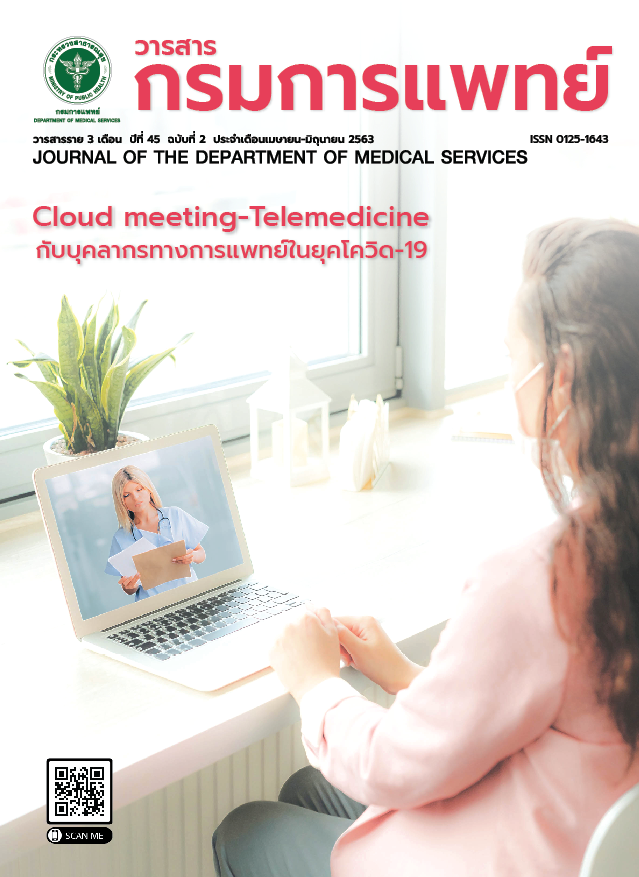A Linear Structural Equation Model of Innovation Work Behavior of Nurses in Regional Cancer Hospital Department of Medical Services
Keywords:
Linear Structural Equation Model, Innovative work behavior, Nurses in cancer region hospital Department of Medical ServicesAbstract
Background: Innovative behavior of nurses is necessary to improve the quality of services in the health care system. Therefore in nursing administration nursing organization administrators should be prepared to promote creativity. To create innovations for use in nursing.
Objectives: 1) to study the level of innovative organization, innovation leadership, domain-relevant skills, intrinsic task motivation, creative-relevant processes and innovative work behavior and 2) to investigate the congruence between a linear structural equation model of innovative work behavior of nurses in cancer region hospital Department of Medical Services.
Methods: To study the quantitative research. Sample was 425 nurses in cancer region hospital, Department of Medical Services selected by multistage random sampling. Research instrument was the 5 rating scales questionnaire with reliability 0.84. Data were analyzed by using structural equation modeling techniques.
Results: 1) Cancer region hospital Department of Medical Services have level of innovative organization and the administrators have level of innovation leadership in high level mean = 3.62, SD = 0.61 and mean = 3.76, SD = 0.71 respectively. 2) Nurses in cancer region hospital , Department of Medical Services showed their level of domain-relevant skills, intrinsic task motivation, creative-relevant processes and innovative work behavior in high level mean = 3.85, SD = 0.53, mean = 3.84, SD = 0.60, mean = 3.70, SD = 0.57 and mean = 3.68, SD = 0.61 respectively. 3) The developed linear structure equation model of innovative work behavior of nursing instructors was congruence with empirical data as criterion as follow: Chi - Square = (Chi - Square = 113.59 df = 57, p-value = .000, GFI = 0.968, AGFI = 0.924, NFI = 0.984, TLI = 0.983, RMSEA = 0.028, RMR = 0.016). All of 5 causal factors jointly explained 89 % of variation in innovative work behavior.
Conclusions: The innovative behavior of nurses in regional cancer hospitals, Department of Medical Services depended on the influence of the organization of innovation leadership in innovation core skills involved in work that influence through internal motivation to perform duties. And the processes related to creation.
References
De Jong JPJ, Den Hartog DN. Measuring innovative work behavior. Creativity and innovation management 2010; 19 : 23-36.
Dorenbosch L, Marloes LE, Marinus V. On-the-job Innovation: The Impact of Job; 2005.
Design and Human Resource Management through Production Ownership. Creativity and Innovation Management 2010; 14: 129-41.
Imran R, Haque M. Mediating effect of organizational climate between transformational leadership and innovative work behavior. Pakistan Journal of Psychological Research 2011; 26: 183-99.
Bossink BAG. Effectiveness of innovation leadership styles: a manager’s influence on ecological innovation in construction projects. Construction Innovation 2004; 4:211-28.
Chutiwong N, Kerdsri N. Analysis of factors that influence the organization of innovation in Thailand. Journal of Business Administration2011; 34: 47-58.
Amabile TM. Componential Theory of Creativity [Internet] 2012.[cited 2013 Feb 7]. Available from: http://www.hbs. edu/faculty/Publication%20Files/12-096.pdf.
Spreitzer GM. An empirical test of a comprehensive model of intrapersonal empowerment in the workplace. American Journal of Community Psychology 1995; 23: 601-29.
Riggs ML, Warka J, Babasa R. Development and validation of self-efficacy and outcome expectancy scales for jobrelated applications. Educational and Psychological Measurement1994; 54: 793-802.
Sawyer JE. Goal and process clarity: Specification of multiple constructs of role ambiguity and a structural equation model of their antecedents and consequences. Journal of Applied Psychology 1992; 77:130-42.
Tierney P, Farmer SM, Graen GB. An examination of leadership and employee creativity: The relevance of traits and relationships. Personnel Psychology 1999; 52:591-620.
Shalley CE, Perry-Smith JE. Effects of socialpsychological factors on creative performance: the role of informational and controlling expected evaluation and modeling experience. Organizational Behavior and Human Decision Processes 2001; 84: 1-22.
Scott S, Bruce R. Determinants of innovative behavior: a path model of individual innovation in the workplace. Academy of Management Journal 1994; 44 : 580-607.
Krause DE. Influence-based leadership as a determinant of the inclination to innovate and of innovation-related behaviors. An empirical investigation. The Leadership Quarterly 2004; 15: 79-102.
Dorenbosch L, Marloes LE, Marinus V. On-the-job Innovation: the impact of job design and human resource management through production ownership. Creativity and Innovation Management 2005; 14: 129-41.
De Jong JPJ, Den Hartog DN. Measuring innovative work behavior. Creativity and Innovation Management. 2010; 19:23-36.
Richard A, Bessant J, Phelps R. Innovation management measurement: a review. International journal of management reviews 2006; 8: 21-47.
Hebenstreit Julia J. Nurse educator perceptions of structural empowerment and innovative behavior. Nursing Education Perspectives 2012; 33: 297-301.
Xiaomeng Z, Bartol KM. Linking empowering leadership and employee creativity: the influence of psychological empowerment, intrinsic motivation, and creative process engagement. Academy of management journal 2010; 53:107-28.
Downloads
Published
How to Cite
Issue
Section
License
บทความที่ได้รับการตีพิมพ์เป็นลิขสิทธิ์ของกรมการแพทย์ กระทรวงสาธารณสุข
ข้อความและข้อคิดเห็นต่างๆ เป็นของผู้เขียนบทความ ไม่ใช่ความเห็นของกองบรรณาธิการหรือของวารสารกรมการแพทย์



